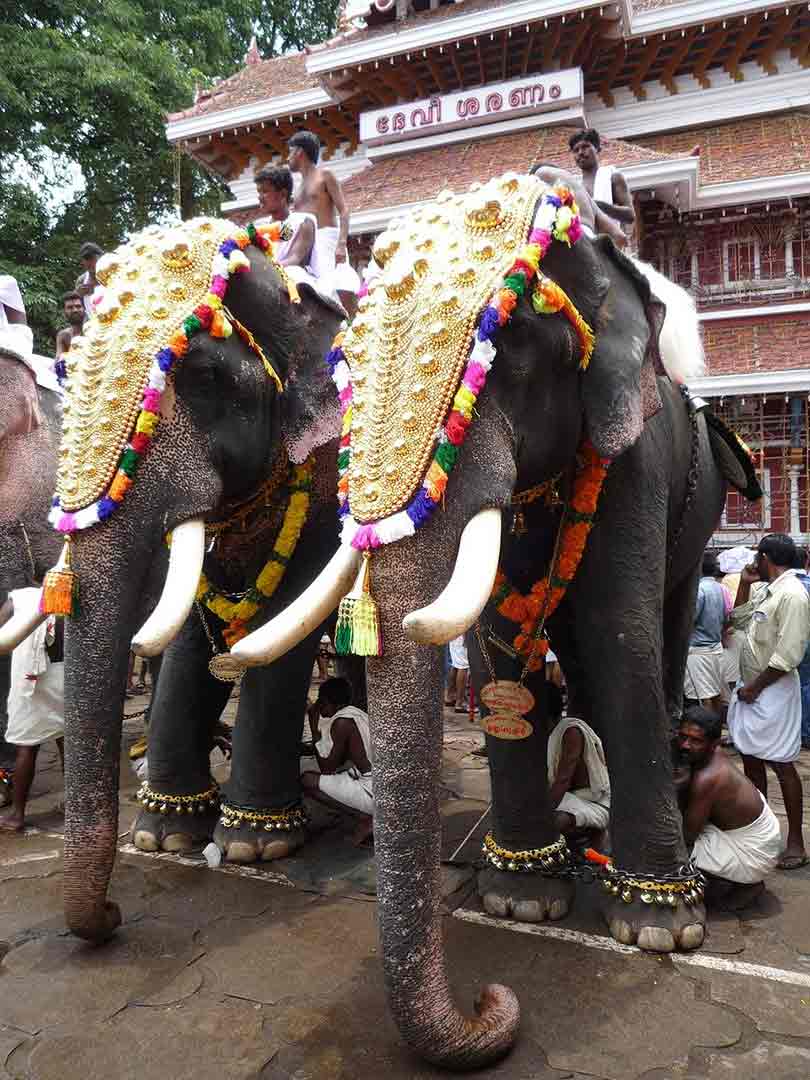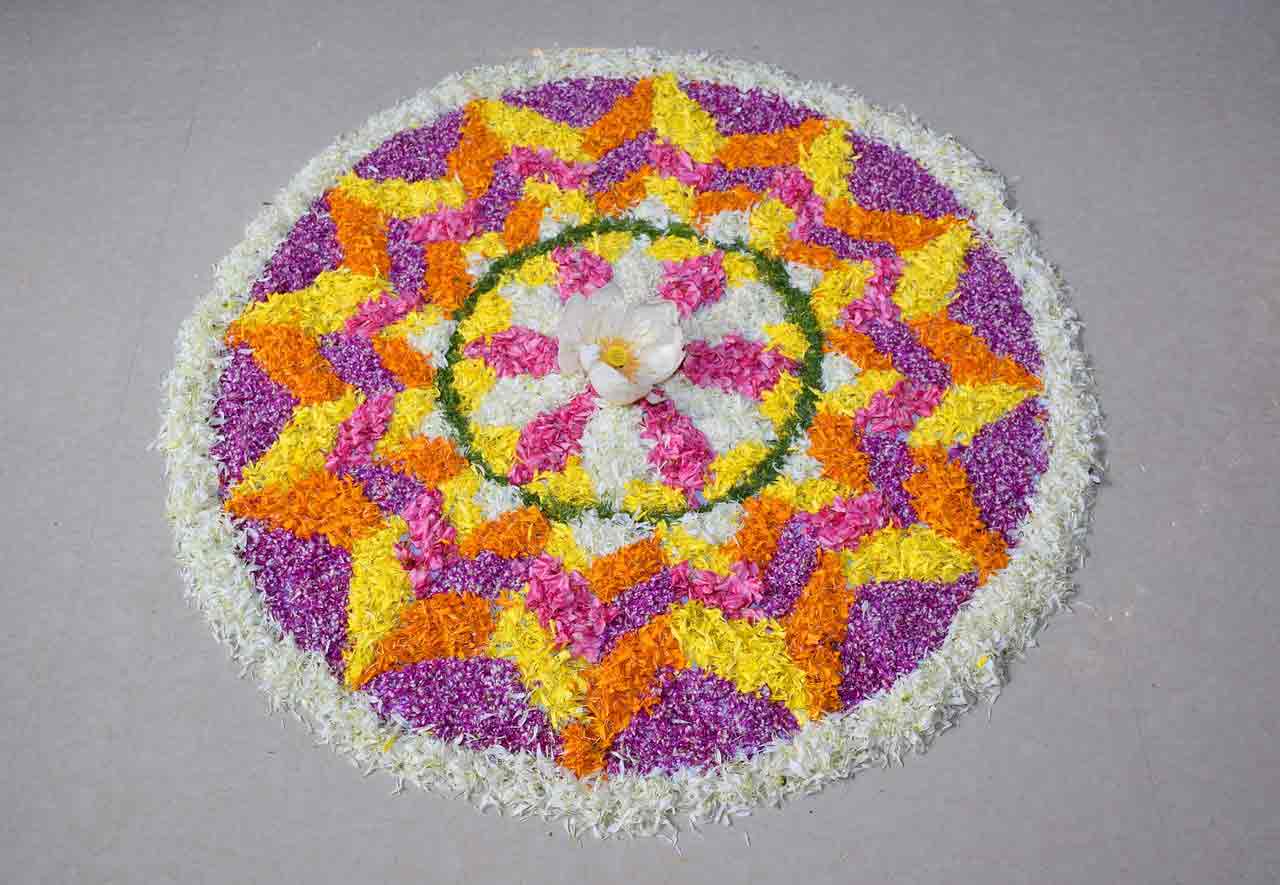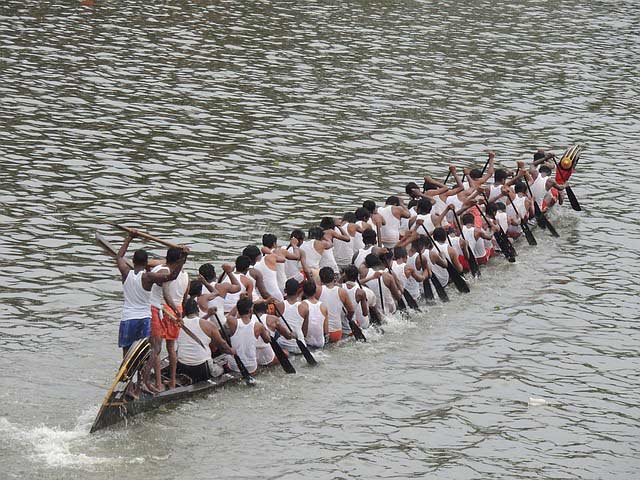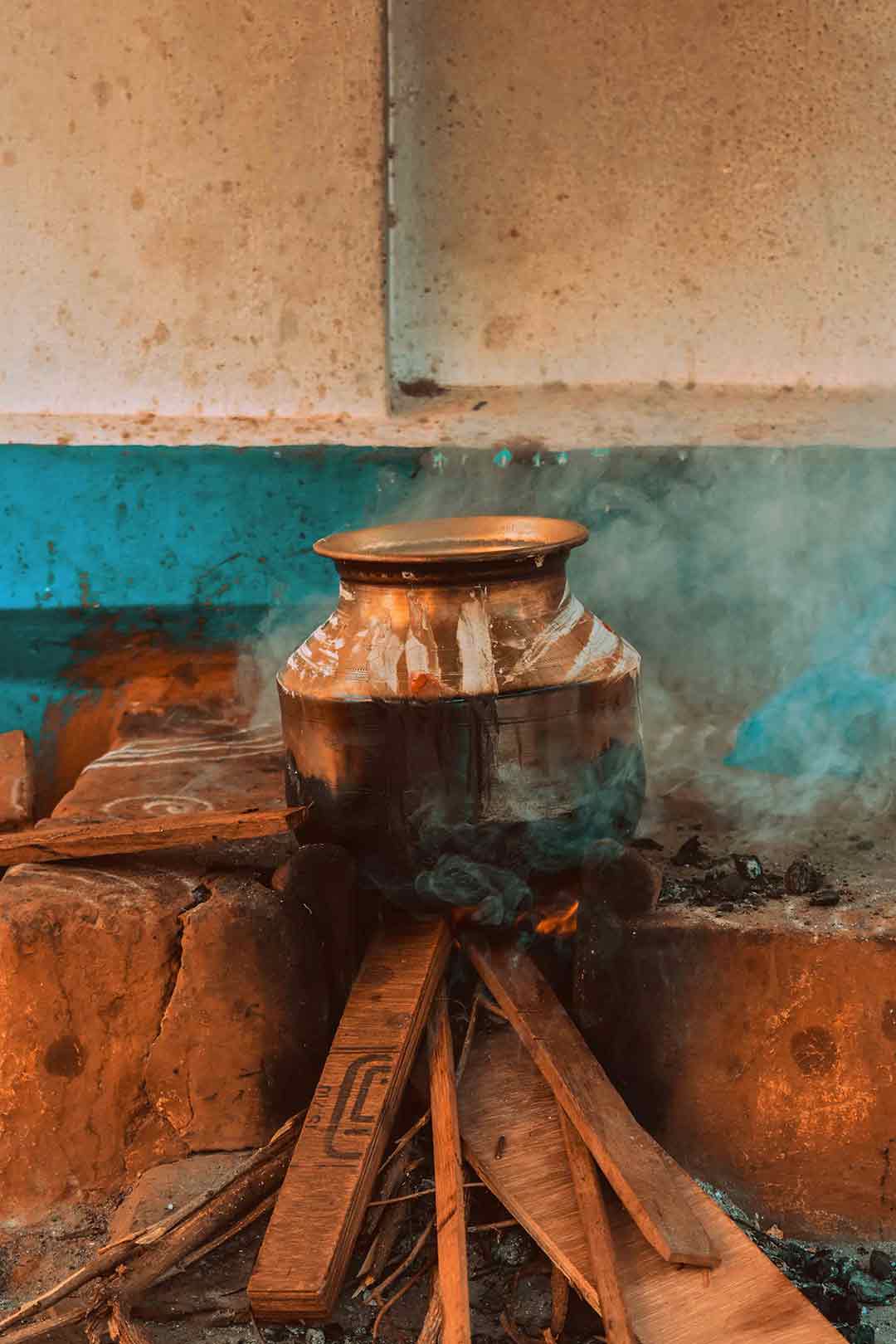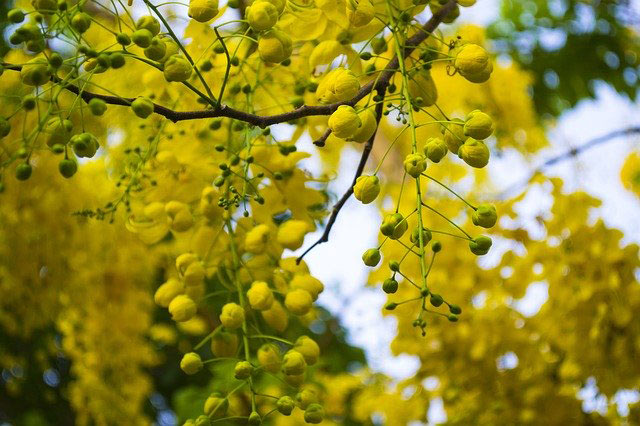The Festivals of Kerala
The Kerala festivals blend in the beauty of dance, music, rituals, and celebrations that can create an enchanting experience for any traveller visiting the state. Here’s a list of some of the most important festivals of Kerala:
Thrissur Pooram
It’s one of the largest and most important festivals held in Kerala. The name comes from Thrissur, the site for the Vadakkunnathan Temple where the festival is celebrated, and Pooram or Puram, meaning the day when the moon rises in the sky with the Pooram star in the Medam month, as per the Malayalam calendar.
This festival was started by Raja Rama Varma, the Maharaja of Cochin. As the story goes, before this festival, the largest festival in the region was Arattupuzha Pooram. In the year 1798, owing to excessive rains, the temples from Thrissur were late for Arattupuzha Pooram as a result of which, they were prevented from attending the procession. Angered at this, the temple authorities complained to Raja Rama Varma, who then united the 10 temples around Vadakkunnathan Temple to a mass festival which became the Thrissur Pooram festival.
The most important thing about this festival is that everything associated with the celebrations are prepared from scratch every year. Another interesting feature of this festival is that the Raja divided the temples into two groups - "Paramekkavu side" and "Thiruvambady side". The principal temples for the Paramekkavu and Thiruvambady are Paramekkavu Bagavathi Temple and Thiruvambadi Sri Krishna Temple respectively. The principal temples lead the processions which finally meet at the Vadakkunnathan Temple.
The celebrations generally include a flag hoisting ceremony (Kodiyettam) a week before the Thrissur Pooram. This is followed by the first round of fireworks, also known as Sample Vedikettu, four days after the flag hoisting. After this, a procession of caparisoned golden elephants, decorated with fans, bells, and umbrellas, is arranged by the two separate groups. The main Pooram festival witnesses a huge gathering of around 50 caparisoned elephants, over 200 artists and musicians.
An important aspect of this festival is its secular nature. All religions and communities participate in the proceedings of the festival. For example, the pandal works are done by the Muslims whereas the umbrella materials are provided by the churches. The Pooram festival concludes with the final round of fireworks and the idols being returned to their respective temples.
The Thrissur Pooram festival is one of the largest gatherings in Asia and attracts devotees from all religions, communities, and sections of society. It’s celebrated in the months of April and May, so you must be prepared for the sweltering heat of South India if you’re planning to attend the festival. Thrissur is easily accessible by road, rail, and air. Thrissur has regular buses and good roads connecting it to all major cities. The Thrissur railway station is the nearest rail access.
Onam Festival
Onam festival occurs at the juncture when the monsoons recede from the Indian subcontinent and the sky and the fields are rejuvenated and vibrant with colours. This is as green as God’s Own Country, Kerala gets.
Onam is one of the traditional festivals of Kerala and is quite famous among the Malayali community. This harvest festival is one of the biggest cultural events that bring together people from various ethnicities and races to commemorate the homecoming of the legendary King Mahabali. The word Onam comes from the Sanskrit word Shravanam or Thiruvonam, one of the 27 Nakshatras in Hindu mythology. Moreover, Thiru in South India is also believed to signify everything related to Lord Vishnu.
Most Indian festivals are linked to a myth or legend and Onam is no different. The significance of the Onam festival comes from the story of King Mahabali who ruled Kerala. The story goes that Mahabali, the demon king and devotee of Lord Vishnu, was so powerful that he had defeated all the gods. When the gods went to Lord Vishnu, he came disguised as dwarf Brahman and asked for three steps of land from the king. Lord Vishnu then covered the entire earth in two steps and in the third step sent the king to hell. But seeing his devotion, Lord Vishnu allowed Mahabali to visit his kingdom once a year. The 10th day of Onam is the auspicious day when Mahabali returns to his kingdom. The significance of the Onam festival is to commemorate the relationship between humans and gods.
Onam festival takes place for 10 days with each day being celebrated in a unique way. Some of the highlights of the Onam festival are:
- Tripunithura Athachamayam - This marks the beginning of the Onam festival. You’ll be able to see golden elephants walking in a procession with humans.
- Snake Boat Race (Vallamkali) - This is one of the biggest attractions of the Onam festival. This is where hundreds of long boats race on the banks of the Pampa River accompanied by enchanting music.
- Tiger Dance (Pulikali) - One of the thrilling aspects of the Onam festival is the Tiger Dance where people dress up in vibrant dresses and give an enthralling performance
Kerala Boat Festival
If you’re planning to visit Kerala in the monsoon season, then you must not miss the Kerala Boat Festival. It’s one of the most colourful festivals in Kerala. The festival, as the name suggests, is a race between hundreds of snake boats. Some of the other types of boats that compete in the races are churulan vallam, iruttu kuthi vallam, odi vallam, veppu vallam, vadakkanody vallam and kochu vallam.
A snake boat, also known as a chundan vallam, is a slender boat, resembling a canoe, that is used by the people of the Kuttanad region in Kerala. This traditional war boat is about 100 to 120 feet long and can accommodate up to 100 rowers. Every village has its own boat which they race during the festival.
The snake boat races have a 400-year old history. Earlier, the boats were used by the rulers of Alleppey, to fight each other in the canals. In one of these battles, a king who suffered losses decided to make a better vessel and that’s how the snake boat was born.
There are 4 major and 15 minor boat races that are held annually in and around Alleppey. The four major races during the Kerala Boat Festival are:
- The holding of Nehru Trophy on Alleppey’s Punnamda Lake
- The oldest race, Champakkulam Moolam, held on the Champakkulam River
- The Payippad Jalotsavamis held on the Payippad Lake
- The Aranmula Boat Race held on the Pampa River at Aranmula
The Kerala Boat Festival is generally held from July to September with the exact dates depending on the phases of the moon. However, the Nehru Trophy Boat Race is the only one which is held in August.
Attukal Pongala Festival
The Attukal Pongala Festival is a 10-day long festival celebrated at the Attukal Temple in Thiruvananthapuram, Kerala. It’s a traditional festival of Kerala that attracts lots of devotees. Held annually during the months of February and March, the Attukal Pongala Festival is one of the most religious festivals in Kerala.
Also known as the Pongala Mahotsava, this auspicious festival is held with a lot of fanfare. It starts as per the Malayalam month of Makaram-Kumbham and concludes with the sacrificial offering of Kuruthitharpanam. On the ninth day of the festival, lakhs of women gather together to celebrate. The gathering is so huge that it’s recognised by Guinness Book of World Records as the largest gathering of women. This is why the temple is also known as the Sabarimala for women.
The preparation of Pongala starts with a ritual known as 'Aduppuvettu' which is the lighting of the Pongal oven, or Pandarayaduppu, in the temple by the chief priest. The womenfolk prepare a rice porridge with jaggery and coconut and offer it to the goddess.
The Attukal temple, which is built by the local family, has a legend associated with it too. As per the myth, the local family had a vision of the goddess in their dreams where the goddess instructed them to build a temple. The deity in the temple is an avatar of Kannaki.
The Attukal Pongala Festival is attended by the women, dressed in their best clothes. Religious songs accompany the celebrations for all the 9 days of the festival. The sword of the goddess is carried by the chief priest who blesses the women by showering holy water and flowers. The Pongala, blessed by the goddess, is then distributed among the devotees.
To reach Attukal, you will have to travel to Thiruvananthapuram as the city has the nearest railways station and airport.
Vishu Festival
Vishu is one of the most important festivals of Kerala celebrated in the states of Kerala, Mangalore, Tulu Nadu, and coastal Kanyakumari. It falls in the month of April every year as per the Gregorian calendar and the month of Medam as per the solar cycle. It’s basically the astrological New Year for Kerala. It marks the completion of the spring equinox as and the journey of the Sun towards the zodiac.
The celebrations of Vishu are more solemn and don’t include the usual pomp and show as in other festivals. On the first day of Vishu, certain auspicious items such as golden blossoms from the Indian laburnum plant, Kani Konna, raw rice, cucumber, fresh lemons, a mirror, money and silver items. Also known as Vishukkani, it’s one of the most important celebrations during this time. People visit their puja rooms with their eyes closed so as to ensure that they see the Vishukkani first before anything else.
Some of the other customs include buying new clothes for the festival, also known as Puthukodi or Vishukodi. Another tradition called Vishukkaineetam is where the elders give money to the young ones in the family. The celebrations also include bursting of crackers by kids as well as a Vishu feast, also known as Sadya, which includes food items such as Veppampoorasam, a neem preparation and Mampazhapachadi, a soup made from sour mango.
Feeling festive?
Festivals are one of the best ways to feel the pulse of a place. If you’re visiting Kerala and are interested in the festivals of Kerala then you can check out some of the packages by Kerala Tour Packages.






